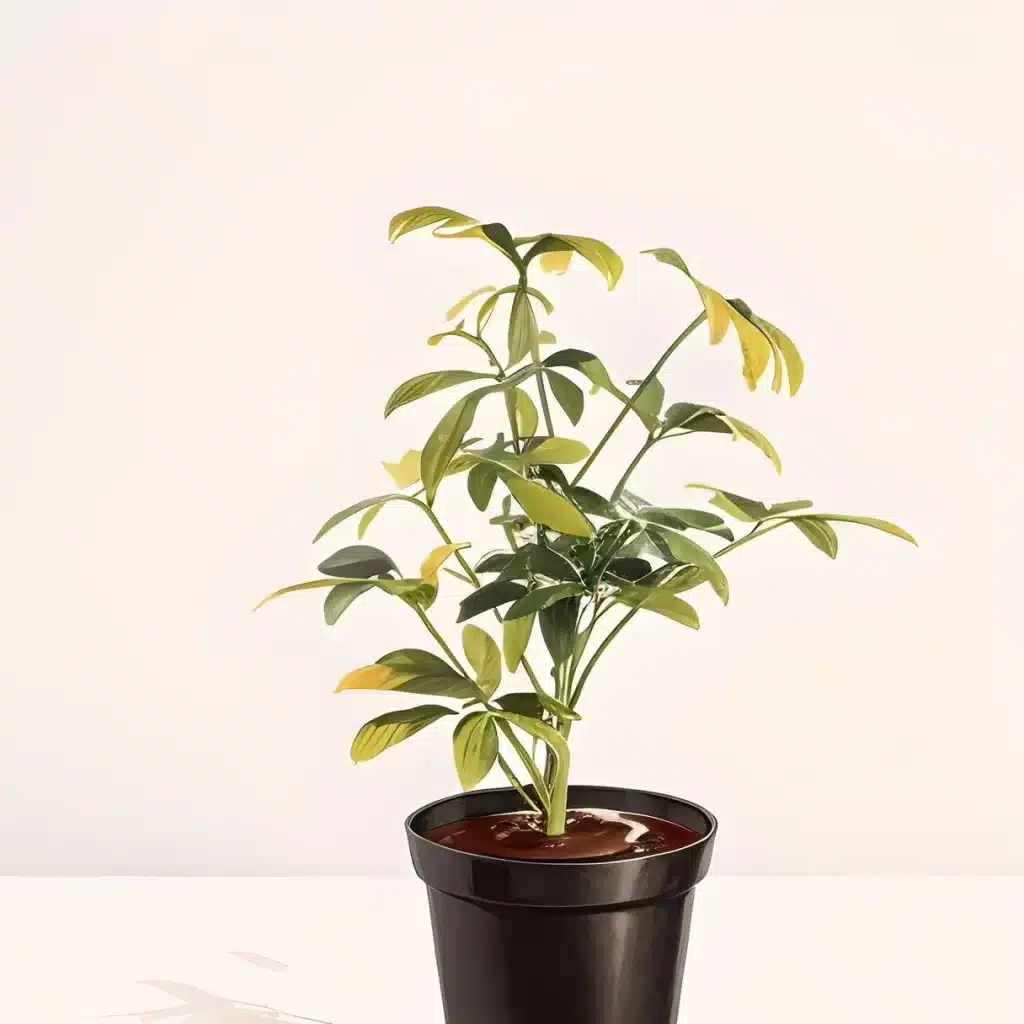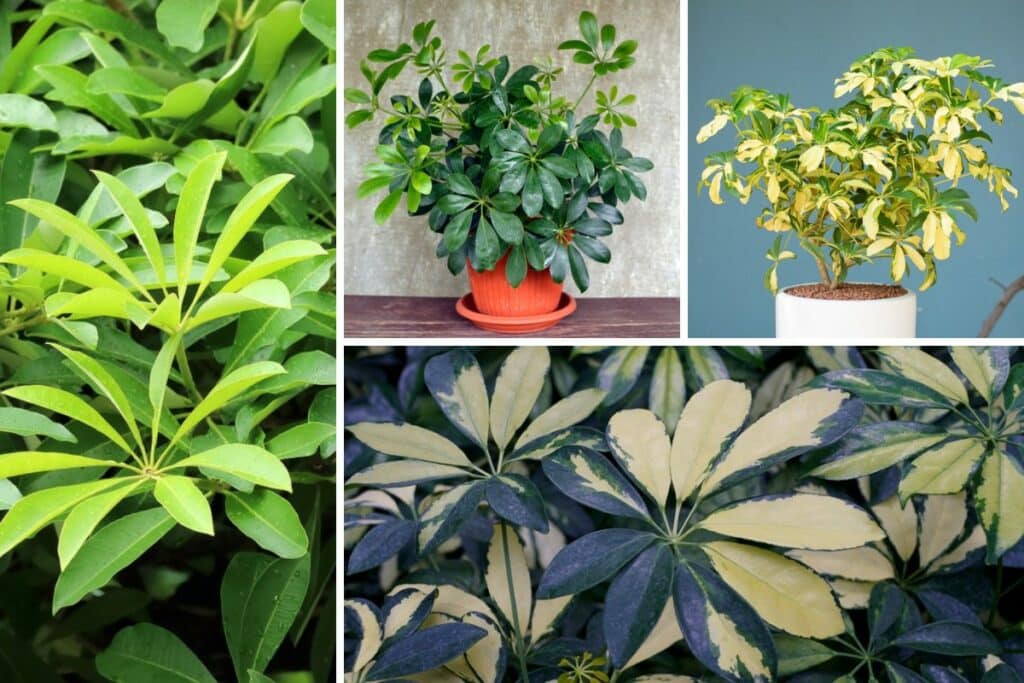Table of Contents
Have you ever heard of Schefflera, AKA Umbrella plants? If you are a gardening enthusiast and want a tiny yet mesmerizing addition to your household, you have come to the right place. In your journey from selecting the right tools for your gardening endeavors to using gardening wood chips as mulch, there comes a phase when you think of exploring verdant plants with a captivating look. This is where you need the umbrella plant. It is a tropical household plant featuring oval green leaves emerging from a central stem. This is why it resembles to umbrella because the oval leafy structure cascades down in the form of an umbrella. So, if you are considering buying one such plant for yourself, we’ve crafted an article guide on umbrella plant care so you don’t have to research yourself. Let’s get through the guide without wasting time.

What is an Umbrella Plant? Really
The umbrella plant, or Schefflera arboricola in scientific terms, is a beloved indoor plant that requires little care and is widely used. It is indigenous to Taiwan and Hainan and is a member of the Araliaceae family. Its name comes from its distinctive features, which include glossy green leaves grouped in an umbrella-like design. In order to prevent waterlogging, it is important to provide strong, indirect bright light and make sure the pot has the appropriate drainage holes. In addition, frequent trimming keeps it in form and promotes bushier growth. Stem cuttings submerged in rooting hormone can be propagated. However, its care depends on being vigilant against pests such as spider mites.

Umbrella Plant Care Tips: Keep Your Little Friend Healthy
Now that you understand the concept of a dwarf umbrella plant let’s review the umbrella plant care guide. This care guide is tailored specifically to the needs of umbrella plants. Once you know the tips for indoor umbrella plant care, you can keep your little friend healthy. This will promote its growth so it doesn’t wilt and its roots don’t rot.
1. Lighting is an Important Part of Umbrella Plant Care
Indirect Bright Light: Adequate lighting is the first step in proper care for the umbrella plant. For optimal growth, place your umbrella plant in an area with bright, indirect sunshine. However, to avoid scorching leaves, steer clear of direct sunlight. Though they survive in bright, indirect light, dwarf umbrella trees can withstand lower light levels.
Plastic Bag Method: This technique can be used to increase the humidity level in your plant. To create a little greenhouse appearance, simply throw a plastic bag over the plant and loosely secure it around the container. By doing so, you can encourage healthy growth and raise humidity levels. So, if you wondering how to care for an umbrella plant, take the hint and make the most of an ordinary plastic bag.
2. Watering: The Soul of Umbrella Plant Care
Watering Frequency: Adequate watering is necessary for the proper care of umbrella tree plants. Folks, your question of how to take care of an umbrella plant lies in the simple basic answer: “Water it.”
When the top inch of soil feels dry, water your plant; do not allow it to grow in damp soil. Moreover, make sure that drainage is adequate, a common problem with overwatered plants, to prevent root rot.
Grow Your Veggie: Regular watering is essential for your plant, but don’t do it too much. Although Cyperus alternifolius enjoys moist soil, the soil must be allowed to dry out slightly between waterings to avoid root rot.
3. Soil and Planting: A Step Toward the Umbrella Plant Care
Soil with Good Drainage: For your umbrella plant, choose potting soil that drains properly to avoid waterlogging and root rot. Moreover, to enhance drainage, think about adding coarse sand or perlite into the soil mixture. Also, pick a pot with drainage holes to let extra water drain and promote strong root growth. it is important for umbrella plant care which you are keeping indoors.
4. Humidity and Temperature Regulation is Necessary for Umbrella Plant Care
Temperature Range: Keep your umbrella plant at a constant temperature of between 65 and 80°F (18 and 27°C). Besides, make sure the plant is protected from cold peaks since abrupt changes in temperature can cause stress to the plant.
Humidity Levels: While they can survive in a variety of humid circumstances, umbrella plants bloom in moderate to high humidity. Moreover, you can raise humidity by placing a humidifier close by or often sprinkling the vegetation.
5. Promote the Growth by Fertilizing: Your Ultimate Umbrella Plant Care Tips
Balanced Fertilizer: During the growing season, feed your umbrella plant with a water-soluble fertilizer that is balanced to supply vital nutrients. Moreover, add fertilizer every 4-6 weeks and dilute it to avoid fertilizer burn. After that, to prevent straining the plant, do not fertilize it when it is dormant in the winter. This is how you care for an umbrella plant.
6. Pruning and Maintenance: Life of Umbrella Plant Care Guide
Regular Pruning: Regular pruning is necessary to keep your umbrella plant in good health and shape. Taking care of the umbrella plant entails pruning off leggy stems to promote bushier growth and eliminating dead or yellowing leaves. In addition, brushing the leaves with a moist cloth can help reduce the buildup of dust while improving photosynthesis.
7. Look Out for Diseases and Pests
Prevention of Pests: Watch out for common pests that might harm umbrella plants, such as scale insects and spider mites. Use materials that are toxic to pets. Furthermore, to avoid harm, keep an eye out for pest activity on the plant and treat infestations as soon as possible. Also, make sure there is enough ventilation surrounding the plant to prevent bug infestations.
8. Stem Cuttings is Essential in Umbrella Plant Care
Propagation: Using stem cuttings to propagate the umbrella plant is very important. It is a very simple procedure. To encourage the growth of roots, take a 4- to 6-inch cutting from a healthy stem and immerse the cut end in the rooting hormone. Additionally, to promote growth, plant the cutting in moist potting soil and place it in a warm, humid area. Also, cover the cutting with a plastic bag to maintain moisture and create a little greenhouse.

Benefits of Growing an Umbrella Plant
If you follow the proper umbrella palm plant care like dipping the cut, propagating the umbrella plant, and watering it regularly, you can enjoy its several benefits. The affection and care for the umbrella plant make it healthy and promote its growth. With the long, leafy plant, you get to relax your mind in a stress-free environment.
1. Air Purification is Offered after Umbrella Plant Care
Formaldehyde, benzene, and trichloroethylene are just a few of the dangerous chemicals that umbrella plants can effectively remove from the air. Indoor surroundings frequently contain these contaminants because of common household objects such as carpets, furniture, and cleaning supplies. Umbrella plants help create cleaner, healthier indoor air by absorbing and neutralizing these pollutants, which is especially advantageous for people who suffer from allergies or respiratory conditions. So, if you opt for proper dwarf umbrella plant care, you can enjoy this benefit.
2. Umbrella Plant Care Provides Stress Relief and Improved Mental Health
According to studies, spending time with indoor plants and variegated umbrella plant care can lead to a relaxing impact on the body and mind, lowering stress levels. It also eventually enhances mental health in general. An umbrella plant in its growing season or any other type of greenery can bring calm and relaxation into your house, which can help relieve tension and anxiety. Taking good care of plants has also been linked to feelings of accomplishment and mindfulness, which improve mood and emotional balance.
3. Improving Cognitive Function and Increasing Productivity: Perks of Proper Umbrella Plant Care
Umbrella plants and other indoor plants have been connected to increased productivity, focus, and cognitive performance. Having plants indoors can help with attention spans, which improves focus and task performance. Whether positioned in a study space, home office, or work location, an umbrella plant can act as a natural catalyst for creativity and critical thinking.
4. Humidity Regulation: Ultimate Temperature Control after Umbrella Plant Care
Through a process known as transpiration, umbrella plants help to regulate the amount of humidity inside spaces. They contribute to the preservation of ideal humidity levels in the surrounding environment by absorbing water from the soil and releasing it into the air through their leaves. This is especially helpful in the dry winter months when indoor heating systems can make the air too dry, which can cause dry skin and respiratory irritation.
5. Biophilic Design and Connection to Environment
Numerous benefits for human health and well-being have been demonstrated by the notion of biophilic design, which involves incorporating elements of nature into interior spaces. An umbrella plant fosters a sense of connection to the natural world by bringing the beauty and energy of nature indoors, encouraging emotions of harmony, balance, and vitality. This biophilic relationship can raise feelings of well-being, lessen stress, and enhance enjoyment of the interior space as a whole.
6. Longevity and Ease of Maintenance
Because of their well-known hardiness and versatility, umbrella plants are a great option for both novice and seasoned gardeners. They are adaptive to a range of indoor conditions and just require moderate amounts of water and light. Furthermore, if given the right care, umbrella plants can live for a very long time, giving you plenty of time to enjoy their advantages and beauty.
Having an umbrella plant in your house has many advantages that go beyond aesthetics. An umbrella plant can significantly enhance your home environment and support a healthier, happier life by doing everything from improving cognitive performance and lowering stress to purifying the air and promoting a connection to nature.
If you want to explore where to grow and propagate the umbrella plant, check out Rachel Jacks’s article.

Types of Umbrella Plants
The word “umbrella plant” can apply to a variety of plant species. However, Schefflera arboricola is the most often planted species in the interior. Nonetheless, because of their similar growth habits or appearance, a few additional plants are also occasionally referred to as umbrella plants. The following plant species are frequently referred to as umbrella plants:
Schefflera arboricola (Dwarf Umbrella Tree)
The most common type of plant known as an umbrella plant is Schefflera arboricola, often known as the dwarf umbrella tree. It is well-known for its glossy, umbrella-shaped green leaves. Schefflera arboricola is often grown indoors since it requires little upkeep and can tolerate a variety of lighting conditions.
Schefflera actinophylla (Australian Umbrella Tree)
The next type is Schefflera actinophylla, a native of Australia, also called the Queensland umbrella tree or octopus tree. It has bigger leaves than its dwarf sibling. In tropical settings, it can reach considerable heights when planted outside, but in colder climates, it can also be grown indoors. This plant needs proper umbrella plant care.
Cyperus alternifolius (Umbrella Papyrus)
Cyperus alternifolius, often known as umbrella papyrus, is commonly called an umbrella plant because of its characteristic umbrella-like leaf clusters, while not belonging to the Schefflera genus. It belongs to the sedge family and is commonly grown indoors in water-filled pots or as a marginal aquatic plant.
Dwarf Schefflera (Schefflera arboricola ‘Dwarf’)
Schefflera arboricola ‘Dwarf,’ also known as dwarf Schefflera, is a compact cultivar of the plant with fewer leaves and a more dwarfed growth habit. It works nicely as a tabletop plant or in smaller areas. It nevertheless has the distinctive umbrella-like look of other umbrella plants even if it is smaller in size.
Schefflera taiwaniana (Taiwanese Umbrella Tree)
A lesser-known species that is native to Taiwan, Schefflera taiwaniana resembles Schefflera arboricola but has smaller leaves and a more compact growth habit. It is frequently grown as a houseplant in colder locations or as a decorative plant in gardens.
Conclusion
To sum up, taking good care of an umbrella plant, especially the Schefflera arboricola, has many advantages that go beyond its aesthetic value. These plants are a great addition to any home because they have several benefits, like improving productivity, fostering mental health, and cleaning indoor air. They can thrive for years with the right care, adding value to your home and raising your standard of living.
Umbrella plants: Nature’s air purifiers!
